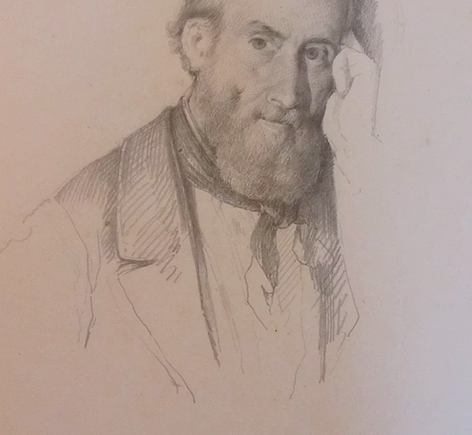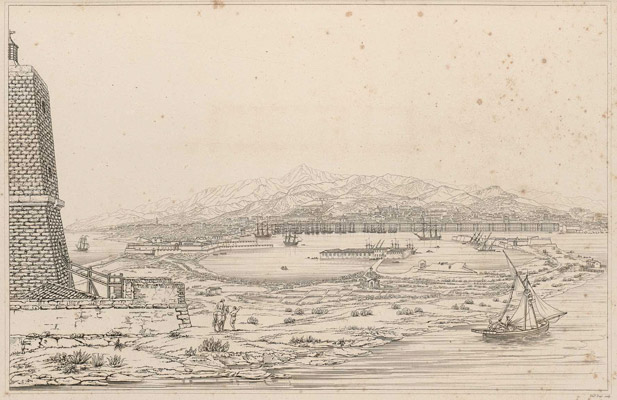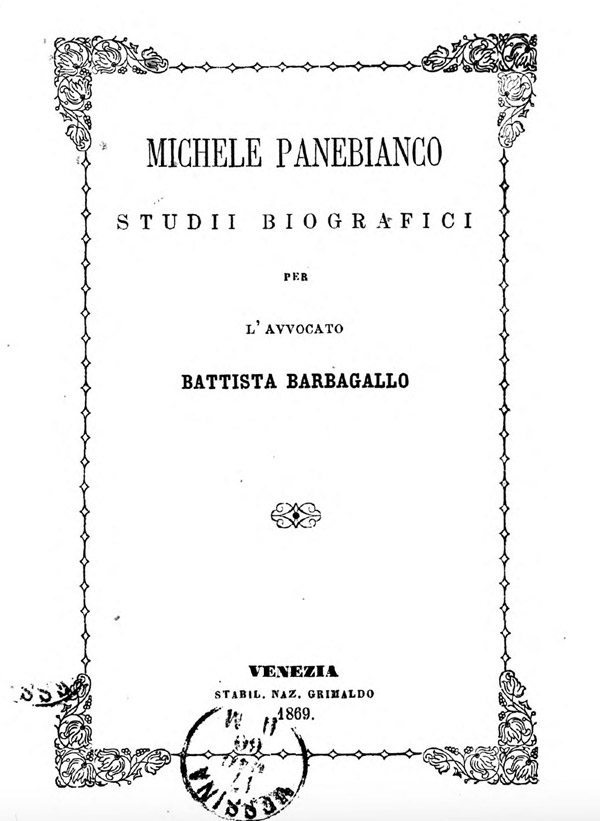Michele PanebiancoBIOGRAPHY

Michele Panebianco.
Autoritratto (seconda metà del XIX sec.)disegno a matita su carta,collezione privata
Born in Messina in 1806, Michele Panebianco is one of the most significant figures in the artistic panorama in Sicily in the 1800s. Basically self taught, after an extremely brief period at the School of Painting of the Royal Carolino College, run by Letterio Subba, in 1828, thanks to a grant from the Council of Messina, he moved to Rome where he attended the Accademy of Saint Luke (winning the School’s first prize for a naked opera he did that very year).He spent time at the artistic studios of both Vincenzo Camuccini and Natale Carta, tending towards a clearly classical, accademic style of painting.
After his return to Messina, Carmelo La Farina commissioned various copies of alterpieces to be hung in many of the churches of the city in 1832, due to the fact that the originals had just been transferred to the Civic Museum in Messina. He thus won the esteem of local patrons, and was able to appease the request for a more accademic style subsequently becoming a much sought after portrait painter by the aristocracy and the wealthy bourgeoise.
There are historiographic references to over three hundred portraits by Panebianco. Among the many which clearly depict his ability in this genre, is the family portrait of Baron don Venerando Pennisi of Floristella, which belongs to a private collection. Several preparatory drawings are preserved along with this work.
In 1842, during Ferdinando II of Bourbon’s visit to Messina, for the solumn festivities of the Madonna of the Letter, Panebianco does several “transperancies”, which were much admired by his contemporaries. These were to be exhibited along the main streets and depicted the return of the ambassadors of Messina from Jerusalem as well as the ambassadors as they receive the Sacred letter. They have been brought down to us today through Panebianco’s friend Tommaso AloysioJuvara’s copperplate engravings.
Between 1845 and 1846 Panebianco takes a long study tour of Naples, Genua, Milan, Venice and Rome, where he meets Francesco Hayez and Luigi Sabatelli. He is also able to meet
painters of the Purist Group and befriend the scupltor Pietro Tenerani.The ramifications of these meetings and the influence the Roman purists had, are captured in the paintings he did on his return to Sicily, particularly those which depict sacred images, as well as in the curtain of The Saint Elizabeth Theatre in Messina, painted in 1852 and destroyed in 1908 due to the tragic earthquake.
Director of the School of Drawing of the Royal University of Messina and member of various accademic circles, including the Pontificial Academy of Fine Arts and Letters of the Virtuous of the Pantheon, Panebianco was particularly active until his death, as can be seen by the numerous works found in a number of churches in Sicily and in Calabria.
Michele PanebiancoPANEBIANCO AND HIS CITY
Michele Panebianco was born in 1806 in a Messina “which was protected by the English allies for ten years until 1815”. He was born in a city where families of the British community remained for more than a century, influencing part of the society, economic, financial and commercial practices common at that time. It is to no surprise then, that the artist worked for and befriended some these families.

J. I. Hittorff,
Veduta del porto e della città di Messina, 1835
The artist was born at a time when the damage caused by the earthquake in 1783 was still visible and during the period when the priviledges of the free port which attempted to bring life back into the city after the calamity, co-existed with insurrections, cholera epidemics, social uprisings and retaliation from the government of the Reign of the two Sicilies and last but not least, at the time of the ferocious Borbonic bombardment from the fort of the very port of Messina itself.
Panebianco grew up in Messina during the slow re-construction and partial urban transformation which apeared to be a “new city” and definitely a city full of building sites to the eyes of the cultivated nineteenth century traveller. (Jakob Hirtoff)
The decision to demolish and subsequently rebuild the famous Palazzata on the port waterfront, damaged by the earthquake at the end of the 1700s, was an opportunity for partial urban redefinition. However, it was also a reinterpretation in other artistic styles and proportions of that constructed, urban manifesto which had synthetically defined this city of work, of revenue, of nobility and of commerce to travellers, merchants, to the port dwellers, to the artists and to the population itself.
Panebianco lived to see the rationalization of important historical venues in his city, the creation of the new Ferdinanda thoroughfare, later called Via Garibaldi, where he lived until his death in 1873. Moreover, he saw the new Municipal building go up in 1820, both the demolition and re-building from 1809 to 1830, the laying of the foundation stone of the new Saint Elizabeth Theatre in 1842, its opening in 1852 and the creation of the Villa Flora Gardens on Saint John’s Esplanade.
It is therefore clear that Michele Panebianco, academic who travels and develops his artistry in the cities of Italy but who returns to Messina as a well-known artist and Director of the School of drawing of the University, is a contemporary of the city’s reconsideration of the historic events which effected it so much.Thus, the redefinition of squares and open spaces, the new direction the city took towards the north and towards the central plain, but also the weaving of gardens and treed walkways in the city centre and along the waterfront as well as the development of a new type of new-concept buildings are all experiences which Panebianco draws on:a long and laborious reconstruction which surrendered the ancient city along with that of the emerging bourgeois city, to the devastating earthquake in 1908.
Michele PanebiancoTHE STUDIES ON THE ARTIST

- Pavone D., Sopra un dipinto ad olio del Sig. Michele Panebianco, in Il Faro, V (1837), 3.
- La Farina G., Messina ed i suoi monumenti, Messina 1840.
- Barbagallo B., M. P. Studii biografici, Venezia 1869.
- Biasini O., Cenni bibliografici degl’illustri contemporanei messinesi, Messina 1877.
- Attard G., Messinesi insigni del sec. XIX sepolti al Gran Camposanto (Epigrafi e schizzi biografici), Messina 1926, II ed. a cura di G. Molonia, Messina 1991.
- Di Paola V., Michele Panebianco (1806-1873), in Il Poliedro, II (1974).
- Mangano E., Su tre pale d’altare di Michele Panebianco, in Archivio storico messinese, s. 3, XXXII (1981), 39.
- Barbera G., Appunti su Michele Panebianco, in Scritti in onore di Vittorio Di Paola, Messina 1985.
- Barbera G., La pittura dell’Ottocento in Sicilia, in La pittura in Italia. L’Ottocento, vol. II, Milano 1991.
- Barbera G., La pittura dell’Ottocento in Sicilia, in Ottocento. Catalogo dell’arte italiana dell’Ottocento, n. 21, Milano 1992.
- Bongiovanni G., Panebianco Michele, in L. Sarullo, Dizionario degli artisti siciliani, II, Pittura, a cura di M.A. Spadaro, Palermo 1993.
- Bongiovanni G., Un ritratto inedito di Michele Panebianco, in Quaderni del Museo archeologico regionale “Antonino Salinas”, VII (2001).
- Vitella M., La pittura dell’Ottocento nella Sicilia orientale, in La pittura dell’Ottocento in Sicilia tra committenza, critica d’arte e collezionismo, a cura di M.C. Di Natale, Palermo 2005.
- Molonia G., scheda n. 34, in Poliorama pittoresco. Dipinti e disegni dell’Ottocento siciliano, a cura di G. Barbera, Cinisello Balsamo 2007.
- Barbera G., Pittori dell’Ottocento a Messina, Messina 2008.
- Giacobbe L., Il Cavaliere di Francesco I. Qualche nota su un ritratto inedito di Michele Panebianco, in Karta, III (2008), 1.
- Barbera G., scheda firmata, in Restauri 2007/2008, a cura di G. Barbera, Messina 2009.
- Lacagnina D., Panebianco Michele, in Dizionario Biografico degli Italiani, vol. 80, 2014.
- Gallo G., Brevi memorie sulla vita del pittore Michele Panebianco da Messina scritte da lui stesso nel 1865, in I manoscritti di Agostino Gallo, a cura di C. Pastena, Palermo 2014.
